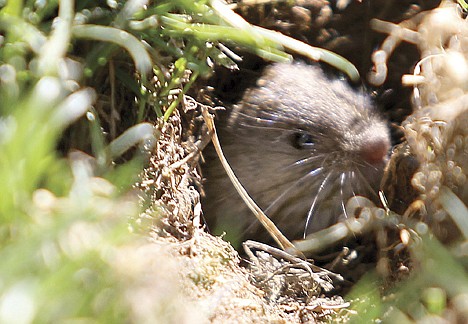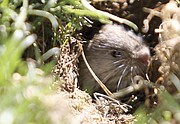A critter conundrum
Amy Huddleston | Hagadone News Network | UPDATED 14 years, 4 months AGO
SHOSHONE - They set up camp under the light of the moon, some stationed around the yard, more huddled in the bushes.
Then the digging began.
Tunnels in which to gather both food stores and strength for the next attack were dug quickly before their opponents could prepare for battle. Armed with generations of experience and the voracious ability to decimate gardens, lawns and fields, the voles settled in to await the right moment to attack.
And attack they did through Jerome and Shoshone, into Richfield and Dietrich. The voles have laid siege to the north side of the Snake River Canyon and despite stomping parties and water torture remain fearless in their attack.
In Shoshone, the voles' narrow tunnels snake through yards, intersecting like inner-city highways. The roots of all things edible have been nibbled away, causing gardeners, homeowners and farmers hours of work and myriad headaches.
For the city and its residents, the worst part is that there is little to be done.
Shoshone City Council President Dan Pierson said city-wide poisoning isn't an option, as any pesticide released within the city to combat the tiny invaders could kill family pets or harm children.
"What can we really do about it?" he asked. "If anyone has suggestions, we'd like to hear them."
The mouse-like rodents aren't a new problem for the valley, though a dramatic increase in their population this spring has caused significant crop problems and has cost citizens thousands of dollars in poisons and alternate killing methods.
Shoshone city maintenance-crew member Parry Silva said the city has watched as the voles chew through City Park and residents' lawns. Although the city has watered the park heavily in an effort to discourage the voles, poison used by citizens can't be used in public areas because of its risk of spreading to pets and children.
"It's really up to homeowners to try to kill them," Silva said. "Some people have been putting traps out and pick up 20 to 30 dead voles out of their lawns every morning."
Despite those losses, the voles remain relentless.
While vole damage is most apparent by its cosmetic effects in cities, fairgrounds and cemeteries, the rodents' attacks are hitting the agricultural community directly in the pocketbook. Shoshone farmer Chris Taber said it's hard to pin down an exact number, but farmers are expecting a 10 percent loss in this year's crop yields due to voles.
Taber and his family farm 3,500 acres of corn, sugar beets and alfalfa. The vole infestation has become progressively worse over the last two years, Taber said, but those years were nothing compared to this year's population explosion. He's spread zinc phosphate pesticide pellets, which cost $10.25 per acre, throughout the farm. Although they've helped, the vole population is far from under control.
The pellets are a one-time-use poison. Once a vole has eaten a pellet, it releases gases in the rodent's stomach, causing it to "blow up," Taber said. Many of the rodents crawl out of their holes to die atop the dirt, where seagulls often snatch them up.
"These fields would just be covered in seagulls the day after we treated them. It was just like a buffet for the seagulls," Taber said, standing on the edge of his hay field. "You could just walk through the field and the seagulls wouldn't even move they just didn't care."
The poison doesn't transfer to the animals that consume the sick voles and is safe for homeowners to use in small portions. The University of Idaho Extension office in Lincoln County is directing concerned citizens to places like Ace Hardware and Valley Co-ops to purchase the pellets.
Not only do the voles eat at crop roots and girdle around corn stalks, they are also eating desert grasses. Usually cattle graze on the wild land, but many ranchers are moving their herds to irrigated pastures to find suitable forage.
Taber isn't sure what to attribute the vole problem to. He said there hasn't been the usual amount of snakes that prey on the field mice because of the wet spring. Another factor is the large amount of "perfect habitat" for the voles to breed in, perhaps due to a newer farming method the strip till. The method saves fuel and reduces field erosion by tilling only land used for seed rows. The crevices it creates, filled with loose matter, also offer a perfect environment for voles.
Lincoln County Extension educator Christi Falen said the voles run in cycles. Last winter created a favorable environment for them to do a lot of damage to alfalfa during winter months.
"They are pretty much in everything," she said. "Hopefully we'll get some cold temperatures to kill them off."
Meanwhile, the war against the little furry beasts continues. As one scampered by Taber's feet, he stomped on it and muttered, "I've really had enough of that."
ARTICLES BY AMY HUDDLESTON

Someone who can use it
Program mentors kids of jailed parents
TWIN FALLS - A resident at Alterra Wynwood retirement center would give Wimpy Spain money on Sundays and tell him to go do something for someone who could use it.

Boy recovers from final surgery in disorder
Cayden Peterson, 7, has Apert syndrome
JEROME - Nikki Peterson is happy that the last big surgery is over and her son's life should be extended.

A critter conundrum
Growers try to curb emerging vole onslaught
SHOSHONE - They set up camp under the light of the moon, some stationed around the yard, more huddled in the bushes.





